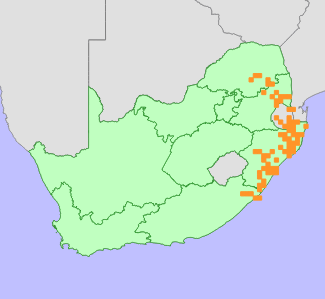|
Scientific Name | Maerua rosmarinoides (Sond.) Gilg & Gilg-Ben. |
Higher Classification | Dicotyledons |
Family | BRASSICACEAE |
Synonyms | Niebuhria rosmarinoides Sond. |
Common Names | Naaldblaar-witbos (a), Needle-leaved Bush-cherry (e), Needle-leaved Spider Bush (e), Slangeierbos (a), Untswantswane (z) |
National Status |
Status and Criteria | Least Concern |
Assessment Date | 2018/10/29 |
Assessor(s) | L. von Staden |
Justification | A widespread species that is not in danger of extinction. It is therefore assessed as Least Concern. |
Distribution |
Endemism | Not endemic to South Africa |
Provincial distribution | Eastern Cape, KwaZulu-Natal, Limpopo, Mpumalanga |
Range | This species' distribution stretches from Sekhukhuneland to the Mpumalanga Lowveld, and it is widespread along the KwaZulu-Natal coast and Pondoland region of the Eastern Cape. It also occurs in Swaziland and Mozambique. |
Habitat and Ecology |
Major system | Terrestrial |
Major habitats | Pretoriuskop Sour Bushveld, Maputaland Coastal Belt, Southern Lebombo Bushveld, Northern Lebombo Bushveld, Swaziland Sour Bushveld, Barberton Serpentine Sourveld, Western Maputaland Clay Bushveld, Malelane Mountain Bushveld, Makatini Clay Thicket, Ohrigstad Mountain Bushveld, Poung Dolomite Mountain Bushveld, KwaZulu-Natal Coastal Belt Thornveld, Pondoland-Ugu Sandstone Coastal Sourveld, KwaZulu-Natal Coastal Belt Grassland, Maputaland Wooded Grassland, Kaalrug Mountain Bushveld, Tshokwane-Hlane Basalt Lowveld, KwaZulu-Natal Sandstone Sourveld, KwaZulu-Natal Hinterland Thornveld, Thukela Thornveld, Thukela Valley Bushveld, Legogote Sour Bushveld, Lebombo Summit Sourveld, Gabbro Grassy Bushveld, Eastern Valley Bushveld, Delagoa Lowveld, Granite Lowveld, Crocodile Gorge Mountain Bushveld, Zululand Coastal Thornveld, Zululand Lowveld, Northern Zululand Sourveld, Tzaneen Sour Bushveld |
Description | Plants grow in dry thornveld, valley bushveld, riverine thicket and forest margins. |
Population |
Population trend | Stable |
Assessment History |
Taxon assessed |
Status and Criteria |
Citation/Red List version | | Maerua rosmarinoides (Sond.) Gilg & Gilg-Ben. | Least Concern | Raimondo et al. (2009) | |
Bibliography |
Boon, R. 2010. Pooley's Trees of eastern South Africa. Flora and Fauna Publications Trust, Durban.
Coates Palgrave, M. 2002. Keith Coates Palgrave Trees of southern Africa. 3rd Edition. Struik, Cape Town.
Killick, D.J.B. 1970. Maerua. In: L.E. Codd, B. De Winter, D.J.B. Killick and H.B. Rycroft (eds). Flora of southern Africa 13:159-171. Botanical Research Institute, Pretoria.
Raimondo, D., von Staden, L., Foden, W., Victor, J.E., Helme, N.A., Turner, R.C., Kamundi, D.A. and Manyama, P.A. 2009. Red List of South African Plants. Strelitzia 25. South African National Biodiversity Institute, Pretoria.
Schmidt, E., Lotter, M. and McCleland, W. 2002. Trees and shrubs of Mpumalanga and Kruger National Park. Jacana, Johannesburg.
Wild, H. 1960. Capparidaceae. In: H. Wild and A.W. Exell (eds). Flora Zambesiaca 1 (Part 1):194-245. Crown Agents for Oversea Governments and Administrations, London.
|
Citation |
| von Staden, L. 2018. Maerua rosmarinoides (Sond.) Gilg & Gilg-Ben. National Assessment: Red List of South African Plants version 2024.1. Accessed on 2025/10/28 |
 Comment on this assessment
Comment on this assessment

